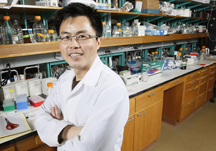Map of substrate-kinase interactions may lead to more effective cancer drugs

W. Andy Tao is mapping the interactions between kinases and their protein targets in an effort to build drugs that better block the reactions that lead to cancer cell formation. (Purdue Agricultural Communication photo/Tom Campbell)
WEST LAFAYETTE, Ind. - Later-stage cancers thrive by finding detours around roadblocks that cancer drugs put in their path, but a Purdue University biochemist is creating maps that will help drugmakers close more routes and develop better drugs.
Kinase enzymes deliver phosphates to cell proteins in a process called phosphorylation, switching a cellular function on or off. Irregularities in phosphorylation can lead to uncontrolled cell growth and are a hallmark of cancer.
Many successful cancer drugs are kinase inhibitors, which block the ability of a kinase to bind with a particular protein on the cell, stopping phosphorylation and the creation of cancer cells.
W. Andy Tao, a Purdue associate professor of biochemistry and member of the Purdue University Center for Cancer Research, said that in later stages of cancers, kinase-inhibiting drugs are ineffective because the kinases adapt, finding new protein targets and forming new cancer cells. He believes that creating maps of all the potential routes for cancer cell formation is a key to developing better cancer drugs.
"I would say that 99 percent of these drugs are effective for a few months in late-state cancers, and then the cancers develop resistance," said Tao, whose findings were published online early in the Proceedings of the National Academy of Sciences. "In the beginning, the cell cannot adjust and it dies. In later stages, the cells find a way. Cancer cells find a way to survive. You block one pathway, and they find another."
The kinase-protein maps Tao is creating identify kinases and the direct protein targets they phosphorylate. His method weeds out other proteins that are not direct targets, but are later phosphorylated as part of a cascade of reactions that begins when direct target proteins are phosphorylated.
Tao compared cells with and without kinases. The phosphoproteins present only when a kinase was present were considered possible targets. Further, the proteins were dephosphorylated, meaning the phosphate groups that had been added by kinases were removed.
The kinase was then re-introduced, and those proteins that accepted phosphate groups from the kinase were deemed direct targets of that kinase. With that information, drugmakers could tailor kinase-inhibiting drugs to ensure that the drug would stop kinases from reaching all potential targets, making the drugs more effective.
"If you understand the network, you can block all the pathways to cure the cancer," Tao said.
Tao's research findings focused on the SYK kinase, which is involved in leukemia and breast cancers. He plans to study other kinases, as well as mutated kinases, to understand whether they have different protein targets.
Tao collaborated with Robert Geahlen, a professor in medicinal chemistry and molecular pharmacology at Purdue. The National Institutes of Health funded the research.
Writer: Brian Wallheimer, 765-496-2050, bwallhei@purdue.edu
Source: Andy Tao, 765-494-9605, taow@purdue.edu
Ag Communications: (765) 494-2722;
Keith Robinson, robins89@purdue.edu
Agriculture News Page
ABSTRACT
Sensitive Kinase Assay Linked With Phosphoproteomics for Identifying Direct Kinase Substrates
Liang Xue, Wen-Horng Wang, Anton Iliuk, Lianghai Hu, Jacob A. Galen, Shuai Yu, Michael Hans, Robert L. Geahlen, and W. Andy Tao
Our understanding of the molecular control of many disease pathologies requires the identification of direct substrates targeted by specific protein kinases. Here we describe an integrated proteomic strategy, termed kinase assay linked with phosphoproteomics, which combines a sensitive kinase reaction with endogenous kinase-dependent phosphoproteomics to identify direct substrates of protein kinases. The unique in vitro kinase reaction is carried out in a highly efficient manner using a pool of peptides derived directly from cellular kinase substrates and then dephosphorylated as substrate candidates. The resulting newly phosphorylated peptides are then isolated and identified by mass spectrometry. A further comparison of these in vitro phosphorylated peptides with phosphopeptides derived from endogenous proteins isolated from cells in which the kinase is either active or inhibited reveals new candidate protein substrates. The kinase assay linked with phosphoproteomics strategy was applied to identify unique substrates of spleen tyrosine kinase (Syk), a protein-tyrosine kinase with duel properties of an oncogene and a tumor suppressor in distinctive cell types. We identified 64 and 23 direct substrates of Syk specific to B cells and breast cancer cells, respectively. Both known and unique substrates, including multiple centrosomal substrates for Syk, were identified, supporting a unique mechanism that Syk negatively affects cell division through its centrosomal kinase activity.
